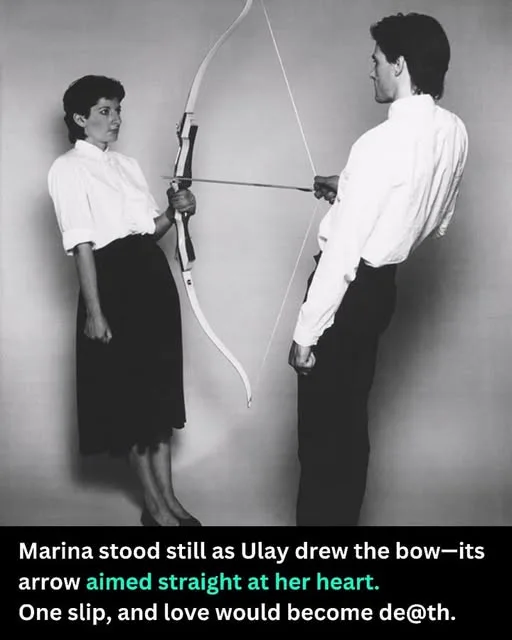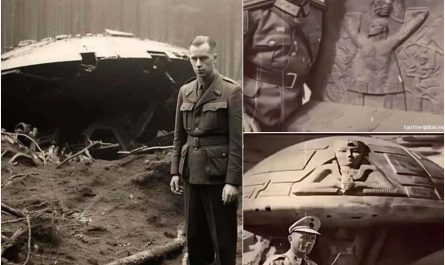Imagine standing perfectly still while someone you love holds your life in their hands—literally. One tiny slip of the fingers, one moment of doubt, and a sharp arrow plunges straight into your heart.

This is not a scene from a thriller. This was art. Real, raw, and terrifying.
In 1980, performance artists Marina Abramović and Ulay turned love into a four-minute countdown to possible death.
The piece is called Rest Energy.
The Setup
A dimly lit room. Silence so thick you can hear breathing.
Marina Abramović stands upright, gripping a large recurve bow with both hands. Ulay—her lover and collaborator of four years—leans backward at a precarious angle, his fingers hooked into the bowstring.
Between them: a small aluminum arrow, nocked and drawn. Its razor-sharp tip rests directly against Marina’s heart, pressing into her white shirt.
They lean away from each other, using their full body weight to keep the bow drawn. The only thing preventing the arrow from flying forward is the equal tension between two human bodies and two human wills.
Tiny microphones are taped to their chests. Their accelerating heartbeats boom through the speakers like war drums.
Four minutes and ten seconds. No safety cable. No trick arrow. No editing.
One tremor, one flinch, one lapse in concentration—and Marina dies.
The Stakes
Marina later recalled:
“In that moment I was not in control. He was completely in charge. I trusted him with my life, and he trusted me not to move and accidentally kill him. It was total trust.”
That’s the paradox at the heart of Rest Energy: Marina holds the bow (symbolically the power), yet she is the one in mortal danger. Ulay appears passive, merely pulling the string, yet he holds the trigger.
It’s a perfect metaphor for the terror and beauty of deep romantic trust: You hand someone the power to destroy you, and you pray they never use it.
The Relationship Behind the Arrow
At the time, Marina and Ulay were not just artistic partners—they were lovers living a merged existence. They dressed alike, shared a birthday celebration on the same day (despite being born years apart), and even described themselves as a two-headed being.
Their twelve-year collaboration (1976–1988) produced some of the most radical explorations of intimacy and pain in art history:
- Breathing in/out of each other’s lungs until they collapsed (Breathing In/Breathing Out)
- Slapping and being slapped for hours (Relation in Time)
- Walking the entire length of the Great Wall of China from opposite ends to meet in the middle—only to break up when they finally embraced (The Lovers)
Rest Energy was the distilled essence of their bond: love as a high-wire act where falling means annihilation.
The Ending
After four minutes and ten seconds—exactly the length of time Marina said a human being can consciously hold complete focus—the tension became unbearable.
Slowly, carefully, they released.
Ulay let go of the string. Marina lowered the bow.
The arrow never flew.
They fell into each other’s arms, hearts still thundering through the speakers, now gradually slowing.
The audience sat in stunned silence, then erupted.
Why It Still Haunts Us 45 Years Later
In an age of carefully curated Instagram relationships and “situationships,” Rest Energy feels almost obscene in its honesty.
It asks questions we prefer to ignore:
- How much of yourself are you willing to risk for love?
- Can you stand perfectly still while someone aims an arrow at your heart—and trust they’ll never let it fly?
- What happens when the person who holds your life eventually walks away?
(Eight years after Rest Energy, Ulay did walk away. Their breakup on the Great Wall remains one of art’s most devastating farewells.)
Yet the piece is not cynical. It’s a love letter written in adrenaline and terror.
Marina once said:
“Real love should feel dangerous. If it doesn’t scare you a little, it’s not deep enough.”
Rest Energy proves she was willing to put her life where her mouth was.
Watch the original footage if you dare. Four minutes has never felt so long—or so fragile.
Because sometimes the most powerful declaration of love isn’t “I’d die for you.”
It’s “I trust you not to kill me.”
And they stand there, arrow trembling, proving it.





